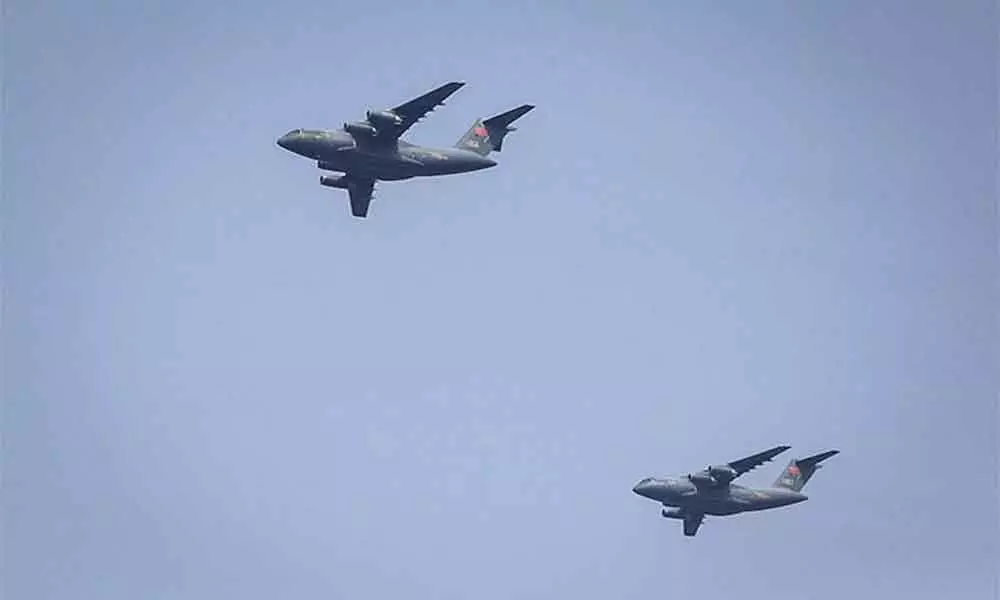Live
- Central Parliamentary Committee Inspects Polavaram Project Progress
- Anantha Lakshmi Int’l School celebrates Sankranti
- Mukkoti Ekadasi observed with religious fervour
- Officials instructed to solve land issues at once
- Alyssa Healy ready to keep wickets for Australia in Ashes series opener
- Illegal sand mining intensifies along Tungabhadra river
- Rain lashes part of Rajasthan, more in store today
- Kerala parents can now monitor their child's academic progress in state-run schools
- IT sector stands out in challenging week for Indian equities
- DTO warns private buses against excess fare
Just In
China, Pakistan fighter planes play war games to prove a point to India


China, Pakistan fighter planes play war games to prove a point to India
China is carrying out joint air force exercises with Pakistan in Sindh as part of the sabre-rattling in response to the Indo-Pacific Quad exercises in which the Indian Navy participated recently.
New Delhi: China is carrying out joint air force exercises with Pakistan in Sindh as part of the sabre-rattling in response to the Indo-Pacific Quad exercises in which the Indian Navy participated recently.
The war games, merely 200 km from the Indian border, are taking place just a week after Chinese Defence Minister Gen. Wei Fenghe visited Pakistan to sign an MoU for closer military cooperation.
The exercises, named 'Shaheen' or Falcon-IX, are underway at the newly operational Bholari air base near Karachi.
According to the Nikkei Asia magazine, the Pakistan Air Force released a video showing the wide range of military aircraft on display in the exercise, which will last until late December.
China has sent its fourth-generation Shenyang J-11 air superiority fighters and Chengdu J-10 multirole jets.
Pakistan, meanwhile, is flying a mix of third-generation Chinese-made Chengdu F-7 interceptors, French Dassault Mirage 5 attack planes and the new multirole JF-17 Thunder ? jointly produced by China and Pakistan.
Malabar exercise of 'Quad' concludes with clear message for China
No American equipment, such as the F-16, has been deployed, the Pakistanis said.
China's Defence Ministry said the drills will "deepen practical cooperation between the two air forces".
Pakistan's air force, has become increasingly dependent on China as the US has cut off military hardware supplies to Islamabad due to its links with Islamic militant outfits.
At the opening ceremony on December 9, Air Vice Marshal Ahmed Sulehri, the deputy chief of Pakistan's air staff, said the exercises "will further enhance inter-operability of both air forces, thereby fortifying brotherly relations between the two countries".
Major Gen. Sun Hong, the assistant chief of staff of the People's Liberation Army Air Force, said they "will improve actual level of combat training and strengthen cooperation".
China's military build-up on the Ladakh border has forced India to counter the move to protect its territorial rights and go in for a rethink about the country's security arrangements and military exercises. This has rattled both China and Pakistan.
India recently hosted the massive Malabar 2020 naval exercise with the US, Japan and Australia.
The inclusion of Australia in the group has strengthened the "Quad," or Quadrilateral Security Dialogue comprising the four democratic countries which are seen as a counter to China's increasing muscle flexing in the Asia-Pacific region and beyond to African shores.
Beijing and Islamabad have also been strengthening their relationship with China providing economic, military and even nuclear support to cash-strapped Pakistan.
The China-Pakistan Economic Corridor (CPEC) a $60 billion communications, energy and infrastructure project to connect western China to the Arabian Sea through the Gwadar port under the Belt and Road initiative forms part of the anti-India strategy.
While the ongoing drills are not the first joint air force exercise between the Chinese and the Pakistanis, the timing, location and size are significant.
The Indian military has been aware of the possibility of a two-front war with China and Pakistan and chief of defence staff, Gen. Bipin Rawat, has stated that the Indian defence forces are prepared to face such a challenge if need be.
Analysts like retired Rear Adm. Sudarshan Shrikhande, India's former chief of naval intelligence, think that the exercise is reflective of China and Pakistan's larger strategic posture toward India.
"The issues of growing coherence and collusion between China and Pakistan have become concerns for India," Shrikhande told Nikkei Asia.
Both China and Pakistan have also been jolted by the Basic Exchange and Cooperation Agreement on Geospatial Cooperation signed in October between the US and India which allows New Delhi access to American satellite military intelligence for better weapon accuracy.
According to Nikkei Asia, even as Pakistan's military continues to draw closer to China, it still wants to maintain cordial ties with the US, with which it has often partnered since joining the US-led alliance against the Soviet Union during the Cold War, an arrangement which helped it both gain Washington's favour and provide benefits in return for decades.
Pakistan's military finds itself in a difficult balancing act between the US and China, given current trade and political tensions between Washington and Beijing.
"When we granted the Americans an air force base to spy on the Soviets in the 1950s, we received American hardware to fight the Indians in the 1960s," a Pakistani officer told Nikkei Asia.
"When Pakistani intelligence supported the Afghan mujahideen in the 1980s, and defeated the Soviets in Afghanistan without one American boot on the ground, we got F-16s in return. The same happened again, when the Americans invaded Afghanistan.
"Yes, we've been transactional allies, but dependable allies. Now, the Americans have found a new friend in the Indians. But they should know better," the officer said.

© 2025 Hyderabad Media House Limited/The Hans India. All rights reserved. Powered by hocalwire.com






